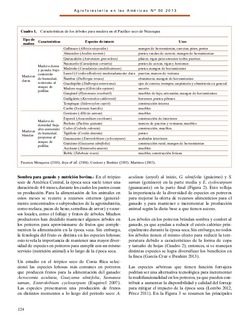| dc.description.abstract | En las zonas ganaderas de Nicaragua hay un interés creciente de los productores por retener y manejar árboles en potreros (árboles dispersos y cercas vivas). Es recomendable que el productor considere la importancia de la multifuncionalidad, entendida como la combinación de varias especies con características diferentes para proveer una variedad de recursos adicionales. La multifuncionalidad brinda una mayor resiliencia al sistema productivo al amortiguar variaciones del clima y también del mercado. Por ejemplo, algunas especies de árboles pueden proveer forraje o frutos en momentos de baja producción de pasto, así como brindar material de carpintería y leña. Los proyectos FunciTree y Silpas han explorado las distintas capacidades de varias especies leñosas, sus características, las funciones en el sistema silvopastoril de la finca y el grado de preferencia por los productores. Este estudio pretende el incremento de la multifuncionalidad en los potreros para mejorar la oferta de bienes y servicios al productor. Mediante un estudio de caso se demuestra el incremento de árboles de distintas especies en potreros como una opción para lograr mayores beneficios de las funciones de las especies a lo largo del año. Trópico seco, Nicaragua, árboles, características, funciones, sistemas silvopastoriles. Multi-functionality for cattle ranching in Nicaragua In Nicaragua’s cattle ranching regions there is a growing interest among cattle farmers in retaining and managing trees in pastures (both individual trees and live fences). Cattle farmers are advised to consider multi-functionality the combination of various species with different characteristics that provide a variety of additional resources and bring increased resilience to the productive system by cushioning variations in both climate and market. For example, some tree species can provide forage and fruit during periods of low pasture production, as well as inputs for carpentry and fuelwood. FunciTree and Silpas projects have explored the different dimensions of various woody species, including characteristics, functions within silvopastoral farm systems and farmer’s preference. This study seeks to increase multi-functionality in pastures through knowledge of trees, their characteristics and their functions on farms, to ameliorate the range of goods and services for the producer. A case study showed that an increase in diverse trees species in pastures led to a diversity of functions for increased benefits all year long. Dry tropics, Nicaragua, trees, characteristics, functions, silvopastoral systems. | nb_NO |
